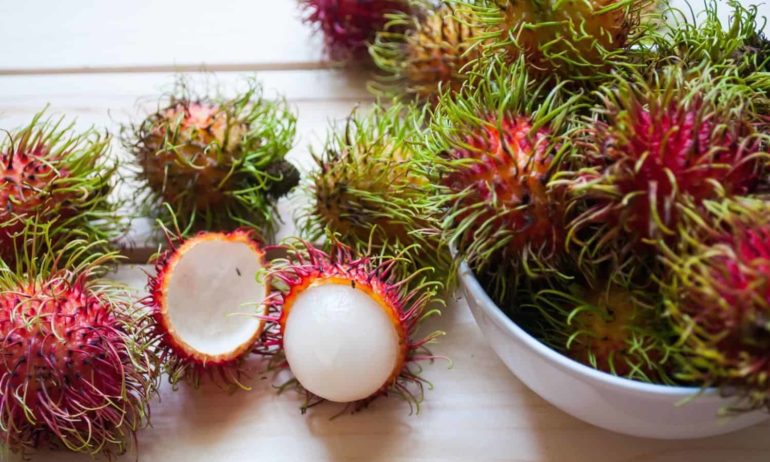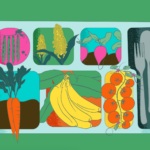Every day, plant species across the globe are disappearing. The U.N. Food and Agriculture Organization (FAO) reports that approximately 75 percent of the Earth’s plant genetic resources are now extinct, and another third of plant biodiversity is expected to disappear by 2050. Up to 100,000 plant varieties are currently endangered worldwide.
Unfortunately, most investments in agriculture are for crops such as wheat, rice, and maize, rather than for more nutritious foods or indigenous crops—and this focus has had devastating consequences. Global obesity rates have doubled over the last 30 years, increasing the risk of diet-related illnesses including diabetes, hypertension, and heart disease in industrialized and developing countries alike.
Many indigenous crops are environmentally sustainable, improve food security, help prevent malnutrition, and increase farmer incomes. Initiatives like the World Vegetable Center (AVRDC)’s Vegetable Genetic Resources System and Slow Food International’s Ark of Taste are working to catalog indigenous species of fruits and vegetables all over the world.
Food Tank has compiled a list of indigenous fruits, vegetables, and grains from many regions that are nutritious, delicious, and contribute to sustainable livelihoods in rural communities across the globe.
AFRICA
1. Fonio: This versatile and gluten-free species of millet from the savannahs of West Africa is nutritious, fast-growing, and suitable to dry conditions. Some ancient belief systems even claim the universe was created through a grain of fonio.
2. Baobab: This enormous African tree has fruits containing a dry pulp that is nutritious, flavorful, and useful as a thickening agent in food processing.
3. Moringa: Native to parts of Africa and South Asia, this versatile and fast-growing tree provides pods, leaves, and seeds that are packed with nutrients. Moringa is drought-resistant, grows well in sub-tropical regions, and even can be used to help purify water.
4. Mongongo: This widely distributed southern African tree has been popular for thousands of years for its nutritious nut, and is now being recognized commercially for its effectiveness as a skin moisturizer.
5. Teff: Highly adaptable and nutritious, teff is an ancient grass native to East Africa that famously withstands extreme climates and is a popular part of cuisines in Africa and India. Teff, which is high in calcium and gluten-free, can be eaten whole or ground into flour.
6. Amaranth: This versatile plant, which grows quickly in the humid lowlands of Africa, is a leafy vegetable typically consumed in places like Togo, Liberia, Guinea, Benin, and Sierra Leone. The plant thrives in hot weather and is an excellent source of protein, vitamins, and essential minerals, including calcium, iron, magnesium, potassium, and zinc.
7. Cowpea: Originating in central Africa, this legume is one of the region’s oldest crops. It is also drought resistant and can thrive in poor soil conditions. The leaves of the plant are also consumed as a vegetable.
8. Spider Plant: This green leafy vegetable, also known as “African Cabbage,” can flourish throughout Africa. It is high in protein, antioxidants, vitamins, and other micronutrients.
9. African Eggplant: The plant is an important indigenous crop because it is high yielding, drought-resistant, stores well, and can be grown in poor soil. The leaves of the eggplant are also consumed, and it can represent an important income source for some families.
10. Argan: This tree, native to the southern coast of Morocco, produces fruit containing a valuable hard nut. This nut contains seeds that produce a deep yellow oil with an unmistakable, rich flavor. In Morocco, there are women’s cooperatives dedicated to producing argan oil.
EUROPE
11. Perinaldo Artichokes: This popular thistle vegetable, valued for its tasty center, is native to the Mediterranean region and was originally cultivated in ancient Greece. Perinaldo, a small Italian town near the French border, produces a variety of artichoke lacking spines or a choke and violet in color. The edible flower bud is a good source of fiber, vitamin C, folic acid, and various minerals. This variety of artichoke is drought resistant and very hardy.
12. Formby Asparagus: Formby asparagus is notable for its coloration: white base, green stem, and purple-tinged tip. The vegetable is rich in protein, fiber, vitamin B6, calcium, magnesium, and zinc. It is a valuable addition to any diet because it aids in protein synthesis, reduces calcium loss, and has antioxidant properties.
13. Filder Pointed Cabbage: The cruciferous vegetable provides a rich source of beta-carotene, vitamins C and K, fiber, and it serves as an antioxidant and anti-inflammatory. Cabbage can be stored cold for months at a time and is eaten in the dead of winter when other vegetables are dormant.
14. Målselvnepe Turnip: This hardy root vegetable variety has been improved over the years through selective cultivation in Norway. It has an excellent, yet strong and distinct taste compared to other turnip varieties. It can be eaten raw, roasted, baked, and boiled, and is frequently used to enhance the flavor of soups, salads, stir-fries, and side dishes. The turnip is an excellent source of vitamin C and potassium.
15. Ermelo Orange: Produced in the town of Ermelo in northern Portugal, these medium-sized oranges are extremely sweet and juicy. Ermelo oranges are distinctive because they have a thin rind and are less fibrous. The fruit is grown on small plots of land overlooking Lima River and pesticides, insecticides, and chemical fertilizers are forbidden in the region.
ASIA
16. Taro: This ancient and enormously popular culinary plant is famous for its root starch and leaves. Originally native to southern Asia, and recognized as a staple of African, Oceanic, and South Asian cuisines, taro is gaining popularity in the western world. Taro can be grown in flooded conditions and is easily digestible.
17. Rambutan: A visually striking red tropical fruit, rambutan is native to Southeast Asia and closely related to the lychee. Also grown in the Caribbean and Africa, the plant is valued for its fruit, leaves, bark, and seeds, which are thought to have medicinal applications.
18. Pomelo: This large original citrus fruit native to Southeast Asia is closely related to the grapefruit, but with a more mild taste, and is often used in desserts, salads, and drinks.
19. Jackfruit: Widely cultivated and popular in its native South and Southeast Asia for thousands of years, this large fruit is rich in vitamin C and protein. Jackfruit is also appealing in that it requires very little maintenance and is resistant to pests and high temperatures.
20. Bitter Melon: Despite its distinctive appearance and bitter taste, this vegetable, originally from the Indian subcontinent, is popular in a number of Asian countries. Those who overlook the vegetable’s warty appearance can benefit in many ways from eating this plant. The gourd is thought to have cancer-fighting properties, help cure diabetes, and can help cleanse the body of toxins.
21. Pamir Mulberry: The Gorno-Badakhshan province of Tajikistan has a mountainous terrain ill-suited for the production of typical grains, including wheat and barley. The Pamir Mulberry grows well in this environment and is an important food source during times of crises. The berries can be eaten raw, dried, whole, ground, or as a jam.
22. Okra: The edible green seedpods of this plant are a common ingredient in soups and sauces and is popular in Indian and Pakistani cuisine. Okra is also an important export crop in the Philippines, Thailand, Malaysia, and Vietnam. The vegetable is a rich source of vitamins and minerals, and the seeds provide quality oil and protein.
23. Mungbean: The mungbean is important in Asian diets and valuable for its easily digestible protein. High levels of iron in the vegetable help improve the diets of the most vulnerable women and children, and mungbean production offers an opportunity for increased income for small-scale farmers. The vegetable can also fix nitrogen in the soil, making it valuable for crop rotations.
24. Lemongrass: This valuable herb is used in many Asian countries, including India, Sri Lanka, Thailand, Vietnamese, Malaysia, Cambodia, and Indonesia. Lemongrass possesses many minerals and essential vitamins, which help control blood pressure and prevent heart disease. It is also valuable for its essential oils, which are known to possess anti-microbial, anti-fungal, antioxidant, and anti-septic properties.
AUSTRALIA AND OCEANIA
25. Lifou Island Yam: This starchy tuber plays an important role in both nutrition and food security in many Pacific Island nations. The vegetable can be roasted, fried, grilled, boiled, smoked, or grated. Yams can be stored for a long time, and the vegetable has a social and cultural significance on many islands.
26. Bunya Nut: Bunya nuts have long been a prominent food in the culture of Australian Aboriginals—so much so that, prior to European settlement, Aboriginal tribes would travel long distances to attend festivals celebrating the Bunya season. The Bunya nut is similar to the chestnut both in appearance and taste. The nuts grow on enormous Bunya pines in the few rainforest regions on the continent, but these trees are increasingly less commonly found.
27. Kumara: Also known as the sweet potato, kumara is cultivated on many Pacific Islands and was a staple crop for hundreds of years. The vegetable is a great source of protein, vitamins A and C, iron, calcium, and dietary fiber.
28. Perry Pear: This formerly wild variety of pears is pressed for its juice. The pear juice is then transformed into a fermented alcoholic beverage. The perry pear was introduced into Australia by the English, but its production is still very limited and many of the perry pear varieties are currently facing extinction. During the height of gold-mining in Australia, perry pears were used to make a safe, low-alcohol content beverage for miners.
AMERICAS
29. Arracacha: Sometimes called apio, this root vegetable, originally from the Andes region, is popular in South American cuisine. Arracacha are used as a staple starch much like potatoes and is made into chips and flour. It is reputed to be an easily digestible starch, useful for infants and the elderly.
30. Custard Apple: Native to Central America, this sweet, juicy fruit with a bumpy green exterior is also cultivated in various tropical countries around the world. The custard apple is also rich in vitamins and has antioxidant properties.
31. Yacón: Also known as the Peruvian Ground Apple, this root vegetable was cultivated throughout the Andes for more than a millennium. Because the vegetable consists mostly of water, it provides isolated inhabitants with a refreshing food resource. Yacón also contains inulin, a low-calorie, high-fiber sweetener that aids digestion while inhibiting toxic bacteria.
32. Hinkelhatz Pepper: The Hinkelhatz pepper has been cultivated by the Pennsylvania Dutch since the 1880s. The plant produces small, heart-shaped peppers with a red or yellow color. Hinkelhatz peppers have a stocky, spicy flavor, so they are frequently pickled or pureed into a pepper vinegar used as a food topping. The pepper is important because it is cold-tolerant, pest and disease-resistant, and a prolific producer.
33. Nova Scotia Gravenstein Apple: This variety of apple is an early-season favorite in Canada because it can be used for a host of different purposes. The flesh is tender and crisp, and the apple’s juice is sweet-tart and intense. The apple is eaten fresh, but is also great for cooking, makes a flavorful cider, and can be stored cold for months at a time.
34. Guayabo: The green fruit, native to Uruguay and southern Brazil, has an appealing sweet and sour taste. The fruit provides a balanced taste profile and an excellent nutritional and medicinal value because of its superior mineral and antioxidant content. In Uruguay, the guayabo is readily adapted to shallow soil and a mountainous environment, allowing the fruit to thrive even in the wild.














